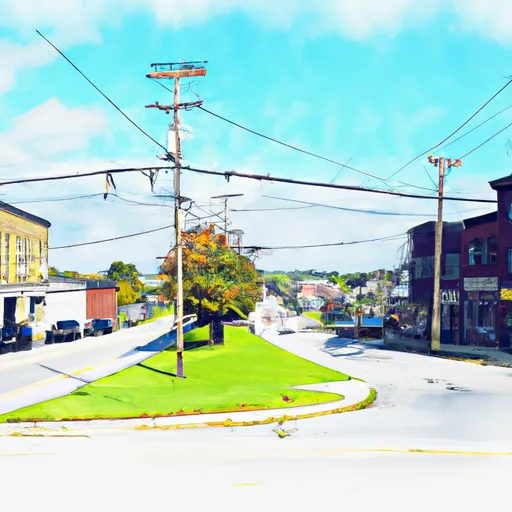-
 Snoflo Premium
Snoflo Premium
Get unlimited access to all our content
With no Ad interruptions! - Start Your Free Trial Login with existing account
Buffalo-Mills
Eden Index
Climate
7.9
•
Recreation
4.5
•
Community
•
Safeguard
4.7/10

Buffalo-Mills is a small town located in Bedford County, Pennsylvania. The climate is characterized by cold winters with average temperatures ranging from 20 to 40 degrees Fahrenheit and warm summers with average temperatures ranging from 60 to 80 degrees Fahrenheit. The hydrology of the area consists of the Buffalo Creek watershed, which drains into the Raystown Branch of the Juniata River. This area is known for its beautiful scenery and offers outdoor recreation opportunities such as hiking, fishing, hunting, and camping. There are also several state parks nearby, including Shawnee State Park and Blue Knob State Park, which offer additional outdoor activities such as swimming, boating, and skiing.
What is the Eden Index?
The Snoflo Eden Index serves as a comprehensive rating system for regions, evaluating their desirability through a holistic assessment of climate health, outdoor recreation opportunities, and natural disaster risk, acknowledging the profound impact of these factors on livability and well-being.
Climate Health Indicator (CHI): 7.9
Buffalo-Mills receives approximately
1017mm of rain per year,
with humidity levels near 83%
and air temperatures averaging around
10°C.
Buffalo-Mills has a plant hardyness factor of
6, meaning
plants and agriculture in this region thrive during a short period during spring and early summer. Most
plants will die off during the colder winter months.
By considering the ideal temperature range, reliable water supplies, clean air, and stable seasonal rain or snowpacks, the Climate Health Indicator (CHI) underscores the significance of a healthy climate as the foundation for quality living.
A healthy climate is paramount for ensuring a high quality of life and livability in a region, fostering both physical well-being and environmental harmony. This can be characterized by ideal temperatures, reliable access to water supplies, clean air, and consistent seasonal rain or snowpacks.
Weather Forecast
Streamflow Conditions
Potomac
Area Rivers
Potomac
Snowpack Depths
Potomac
Reservoir Storage Capacity
Potomac
Groundwater Levels
Recreational Opportunity Index (ROI): 4.5
The Recreational Opportunity Index (ROI) recognizes the value of outdoor recreational options, such as parks, hiking trails, camping sites, and fishing spots, while acknowledging that climate plays a pivotal role in ensuring the comfort and consistency of these experiences.
Access to outdoor recreational opportunities, encompassing activities such as parks, hiking, camping, and fishing, is crucial for overall well-being, and the climate plays a pivotal role in enabling and enhancing these experiences, ensuring that individuals can engage in nature-based activities comfortably and consistently.
Camping Areas
| Campground | Campsites | Reservations | Toilets | Showers | Elevation |
|---|---|---|---|---|---|
| Hawk | 15 | 1,381 ft | |||
| Wolf Gap | 10 | 2,245 ft | |||
| Lorain Borough Park | None | 1,316 ft | |||
| Spring Gap - C and O Canal National Park | 19 | 563 ft | |||
| Shawnee State Park | None | 1,254 ft | |||
| Rocky Gap State Park | 278 | 1,231 ft | |||
| Trout Pond | 70 | 1,995 ft | |||
| Adams Croyle | None | 1,688 ft | |||
| Short Mountain WMA | 74 | 2,136 ft | |||
| Blue Knob State Park | None | 2,576 ft |
Nearby Ski Areas
Catastrophe Safeguard Index (CSI):
The Catastrophe Safeguard Index (CSI) recognizes that natural disaster risk, encompassing floods, fires, hurricanes, and tornadoes, can drastically affect safety and the overall appeal of an area.
The level of natural disaster risk in a region significantly affects safety and the overall livability, with climate change amplifying these risks by potentially increasing the frequency and intensity of events like floods, fires, hurricanes, and tornadoes, thereby posing substantial challenges to community resilience and well-being.
Community Resilience Indicator (CRI):
The Community Resilience Indicator (CRI) recognizes that education, healthcare, and socioeconomics are crucial to the well-being of a region. The CRI acknowledges the profound impact of these elements on residents' overall quality of life. By evaluating educational resources, healthcare accessibility, and economic inclusivity, the index captures the essential aspects that contribute to a thriving community, fostering resident satisfaction, equity, and social cohesion.

